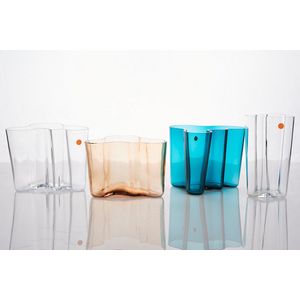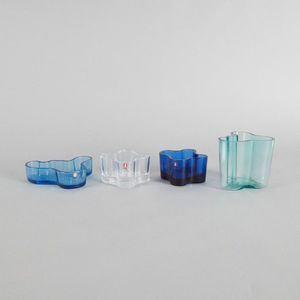
Alvar Aalto Amethyst Vase with Box, 1936
Alvar Aalto (Finnish, 1898-1976), Vase, designed 1936, manufactured by Iittala, amethyst colour glass, with box, height 16 cm. Provenance: Anibou, Sydney

Aalto's Iittala Vases: Clear, Copper, Turquoise (4)
Alvar Aalto (Finnish, 1898-1976), four vases, designed 1936, manufactured by Iittala, two graduated clear glass, one copper glass and one turquoise, all signed to bases, one chipped (4), height 16 cm. Provenance: Private Estate collection, NSW

Aalto's Savoy Glass Bowls in Blue and Smoky Grey
Alvar Aalto for Iittala, two Savoy glass bowls, in blue and smoky grey, both marked to the base, one with manufacturer label to the side, the larger, width 19.5 cm

Alvar Aalto Iittala Blue Glass Vase Set
A suite of four small vases designed by Alvar Aalto for Iittala, in blue and clear glass. Impressed manufacturer's marks to bases. Largest height 10 cm, width 11.5 cm

Iittala Alvar Aalto Ruby Red Glass Vase - Original Design
Iittala Alvar Aalto 'Savoy' ruby red glass vase, hand blown original design 1936 Finland, etched mark 25 cm high

Alvar Aalto Iittala Glass Vase, 1960
Alvar Aalto 'Savoy' Finnish glass vase for Iittala, circa 1960, acid etched 'Alvar Aalto', 16 cm high, 21 cm wide

Aalto Glass Vases and Anibou Vase
Alvar Aalto (Finnish, 1898-1976) three vases, designed 1936 manufactured by Iittala, white, amber and clear glass, signed, together with an Anibou green glass vase (4)

Littala Alvar Aalto Collection: 3 Clear Glass Vases (9.5cm)
Three Littala Alvar Aalto collection Maljakko vases, clear glass in original packaging, height 9.5 cm

Iittala Alvar Aalto Collection: 3 Clear Glass Vases
Three Iittala Alvar Aalto collection Maljakko vases, clear glass in original packaging, height 9.5 cm

Alvar Aalto Savoy Vase
Alvar Aalto (1898-1976) Savoy vase, design introduced 1936 manufactured by Iittalla, c.2000 glass stamped to base. Height 16 cm Martin Eidelberg ed, What Modern Was, design 1935-1965, Harry N. Abrams Inc Publishers, New York, pg97



 Loading more...
Loading more...